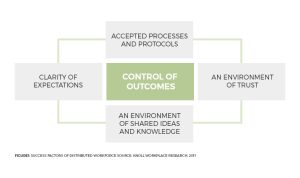In a world of global competition it comes as no surprise that we also need a global workforce. The concept of hierarchy is long forgotten and more collaborative environments are created embracing the changes on the market. Companies are fast transforming their business into digital leveraging social, mobile, analytics and cloud technologies to stay competitive. Moreover, we are witnessing dramatic changes in the workplace. The term “alternative workplace” has emerged which combines non-traditional work practices, settings and locations. What is more important the changes are occurring both on the demand and supply side on the job market.
On one hand organizations are taking advantages of the changes to cut costs and tap into the global talent pool. They are replacing expensive face-to-face meetings with remote technologies, and combining centralized workplaces with alternative workplace programs creating distributed teams who work remotely from different locations in the world.
On the other hand the generation Y who has grown up being constantly connected digitally and globally have significantly different attitude towards work and the workplace. They are asking for more flexibility, greater work autonomy, prefers mobile working and multi-tasking. Without a doubt, this generation is more comfortable working collaboratively as a team in multi-cultural settings with a variety of technologies.
“As a result, organizations increasingly represent a complex web of employees, suppliers, and customers both collocated and dispersed around the world.”
Although there has been some scepticism that decentralization and dispersion of teams can negatively affect the productivity and the brand identity, the book “Distributed Team Collaboration in Organizations: Emerging Tools and Practices” discovers that companies with distributed teams actually reported an increase in innovation behavior of 93% and budget improvements by 50%. Moreover, the teams presented greater willingness to help each other and expressed improved job satisfaction by 80%.
However, these benefits can only be achieved if and when the virtual distance is well managed. There are five crucial factors which are the make or break of successful distributed teams (Figure 1).

Good working practices are essential for success regardless whether we are talking about centralized company or virtually dispersed organization. However, the working processes and protocols become crucial for smooth functioning of distributed teams, especially the acceptance of the same.
“You may be able to get away with poor practices when you are all in one location, but you must establish good work practices if your group is distributed”
Joe Aki Ouye, Ph.D
Second, according to John Gabarro of Harvard University “the structuring of expectations is the single pattern that contributes positively to productivity and satisfaction.”
Next, trust is always top priority of organizations which functions as flat organizations but its importance is even more emphasized in the digital realm. This is closely related to the next success factor of environment of shared knowledge and ideas. Namely, if you don’t trust others on the team, you are not likely to freely share information and cooperate in controlling the outcomes. Trust is increased when members of the team get to know each other better. This can sometimes be challenging in the digital reality, but this is where social media comes as an enabler of building and nurturing global relationships.
“Social media is replacing the conversation that used to took place around the company water cooler.”
Finally, controlling the outcomes can provide insight on how to improve the communication and functioning of the distributed team.
Of course, not all is as simple and easy. Nevertheless, in its core the decision to include distributed workforce on your team it’s a change initiative and should be implemented carefully. The success factors mentioned in this article are only one side of the process. The other part represents the technical side where the right communication, data storage and sharing technologies can either ease or destroy the transformation process.
I would love hear your experience of working with a distributed team. If you still haven’t had the chance to be part of such a dynamic environments stay tuned as next week I share the experience of the extended (distributed) team in my company working remotely in Macedonia for global companies originating from Sweden.
Meanwhile you can check which companies worldwide are already reaping the benefits of this new collaborative working environment: http://www.flexjobs.com/blog/post/76-virtual-companies-and-distributed-teams/